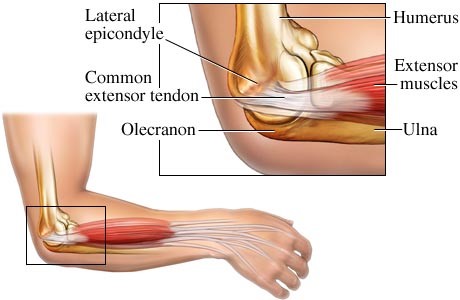Tennis Elbow (Now known as Lateral Epicondylagia / Lateral Epicondyle Tendinopathy).
Lateral epicondylagia is an outside of the elbow condition that is the result of overload and overuse of the wrist extensor muscles. Previously known as tennis elbow, the condition can appear in tennis players, however, it appears in a significantly larger population group including tradespeople and golfers.
The condition refers to pain caused by a change in the tendon’s structure, due to an increase in load and activity.
It is important to note that lateral epicondylagia is often a much easier condition to diagnose than to treat.
Depending on the stage and severity of the condition, the rehabilitation often requires persistence, exercises and activity modification and takes time.
Anatomy
The symptoms are generally felt through the common extensor tendon on the outside of the elbow and may radiate further into the back of the forearm.

Cause
The cause of lateral epicondylagia can generally be attributed to an increase in load beyond the capabilities of the individual. This can be a sudden change in intensity, frequency or duration of the work/sport activity, or can be more subtle such as a change in manual working conditions.
Treatment
Treatment for lateral epicondylagia often involves more than a ‘wait it out’ approach. Based on an assessment of the elbow, as well as the neck and whole upper limb, your physiotherapist will likely provide hands-on treatment to provide some short-term symptomatic relief, as well as an exercise and/or loading program to rehabilitate the tendons of the elbow.
Treatment and the amount of load (exercise or daily activity) recommended will depend on the individual, severity of the symptoms, length of time of the symptoms and the ability to modify your activity.

